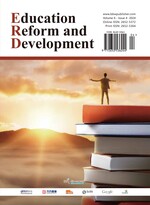Abstract
The concept of a mathematical model is the main expression of the core quality of mathematics in junior middle school, which runs through all the contents of mathematics teaching in middle school. In the “2022 Compulsory Education Curriculum Standards,” mathematics teaching requires an overall grasp of mathematical ideas. Teachers should pay attention to the model concept of the ideological method of explanation and application in the teaching process, which can improve the teaching ability of teachers and is more conducive to students’ development. The new curriculum reform further improves students’ application awareness in the cultivation of core competencies.
References
Huang P, 2022, Penetration of Mathematical Culture in High School Mathematics Textbooks: A Case Study of Fibonacci Numbers. Mathematics Learning and Research, 2022(6): 122–124.
Li X, Cai W, 2019, Research on Mathematical Modeling in Primary School. Research and Review on Education, 2019(05): 68–72.
Cheng M, Wang K, 2023, From “Mathematics Essence” to “Mathematics Essence”—A Comparative Study Between the 2011 Edition and the 2022 Edition of Compulsory Education Mathematics Curriculum Standards. Journal of Academic Education, 2023(8): 80–86.
Ministry of Education of the People’s Republic of China, 2022, Mathematics Curriculum Standard for Compulsory Education (2022 edition), Beijing Normal University Press, Beijing, 1–11.
Chen Y, Ge W, 2020, The Practice and Thinking of Integrating Mathematics Culture into Senior Three Class—Taking Fibonacci Number as an Example. Middle School Mathematics Monthly, 2020(10): 27–30.
Liu J, 2021, Cultivating Junior High School Students’ Modeling Thoughts and Improving Their Core Mathematics Literacy Through a Probe into “Acute Angle Trigonometric Function” as an Example. Communication on Mathematics Teaching, 2021(08): 28–30.
Chen Y, 2023, Research on Mathematical Model Teaching Based on Middle and Small School Connection—Taking Profit Problem as an Example. Fujian Education, 2023(49): 52–54.
Wu S, 2023, Discussion on the Cultivation of Mathematical Model Concept for Junior Middle School Students. Test Questions and Research, 2023(27): 80–82.
Hou Y, 2023, The Penetration of Mathematics Culture in the Math Questions of College Entrance Examination—Taking the New National College Entrance Examination II Questions from 2019–2023 as an Example. Research on Mathematics Teaching, 42(6): 54–60.
Chang L, 2018, Research on Teaching Design of Plane Geometry Mathematical Modeling Based on Geometry Sketchboard Software, dissertation, Xizang University.
Tan Q, 2020, A Method for Cultivating Good Mathematical Modeling Ability of Junior High School Students from the Perspective of Core Literacy. Exam Weekly, 2020(43): 73–74.
Liu Y, 2021, Analysis of Teaching Strategies for Junior Middle School Math Problem Solving from the Perspective of Core Literacy. Knowledge Library, 2021(08): 165–166.
Yang X, 2021, Strategic Thinking on Cultivating Students’ Core Literacy in Mathematics Teaching in Primary Schools. Exam Weekly, 2021(73): 85–87.
Li X, 2020, Initiative: The Pursuit of Quality in Deep Teaching—An Example and Reflection on a High-Quality Demonstration Course “Fibonacci Series.” Educational Science Forum, 2020(16): 44–46.
Wu J, 2023, The Teaching Design of Fibonacci Series and the Golden Section. Mathematics Education in China: Senior High School Edition, 2023(5): 53–57.
